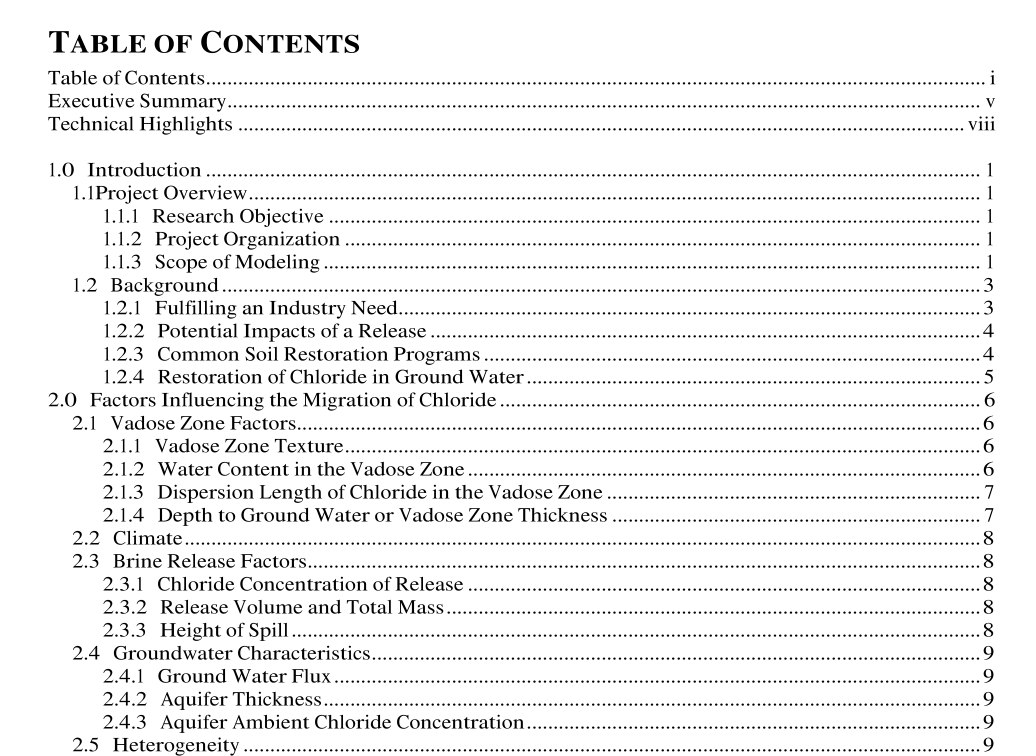API Publ 4734 pdf download

API Publ 4734 pdf download.Modeling Study of Produced Water Release Scenarios
A sensitivity analysis with over 2000 scenarios simulated shows that the initial depth of the produced water (spill height) and the chloride concentration of the brine has the greatest affect on ground water quality predictions. These two factors were combined into a single factor: chloride loading, or “Release Chloride Mass” (g/m 2 ) – a parameter that can be measured in the field or calculated with known release characteristics. The second most important factor is aquifer thickness, which basically determines the volume of ground water available for dilution of the chloride seepage (flux) from the vadose zone to the aquifer. Other factors certainly influence the predictions as well, but accurate prediction of possible ground water impairment is impossible without a reasonable knowledge of chloride loading and aquifer thickness. Factors influencing chloride migration are introduced in Chapter 2. Sensitivity analysis of factors determining chloride fate are covered in detail in Chapter 4. A guide to understanding the role of key produced water release and chloride fate factors is presented in Chapter 11. The Rate of Migration and Distribution of Chloride in the Vadose Zone In addition to evaluating which scenarios have the potential to impair ground water quality, this study examined the time required for chloride to migrate through the vadose zone into ground water. The modeling results suggest that chloride molecules will migrate from the ground surface to ground water as long as there is a net downward flux to the water table.
Model predictions of the time required for the maximum chloride concentration to reach an adjacent well were used to measure the sensitivity of each factor to the movement of chloride through the vadose zone. Results indicated that climate, vadose zone texture, and ground water depth exerted the most control on this prediction. Other factors were relatively unimportant in the prediction of the time of transport. The vertical distribution of chloride in the vadose zone after a release was simulated for two representative climates: Hobbs, New Mexico (arid climate) and Shreveport, Louisiana (humid climate). The movement of chloride during the first 5 weeks after a release did not depend on climate, but rather on the particular weather conditions (e.g., rainfall events) after the hypothetical release. Review of 96 scenarios modeled showed that the center of mass (of chloride) after 5 weeks of transport was sometimes deeper in Hobbs and sometimes deeper in Shreveport, despite the fact that other input parameters were held constant. The depth of penetration depended strongly on weather conditions and, more importantly, on the soil texture. The modeling shows that chloride migration during the first 5 weeks after a release accounts for 70% of the chloride migration observed after 50 weeks. On average, the center of mass is predicted to move about 1 m in the arid climate and 3 m in the humid climate. The average penetration depth for the center of mass for clay, clay loam, sandy loam and sand are about 0.2, 0.3, 2.0, and 5.0 m respectively.For many scenarios, chloride migration from the ground surface to a 30-m deep aquifer requires decades and, in the arid climate, sometimes centuries. The migration of chloride over time in 22 different scenarios was examined. As expected, the maximum predicted concentration of chloride decreases with the depth of penetration: the center of mass attenuates with vertical transport. In a humid climate the observed attenuation is faster than in the arid climate. The climatic conditions do not influence the amount of attenuation, only the time frame necessary for the attenuation to take place. Arrival time of the maximum chloride concentration is discussed in detail in Chapter 4, section 4.4.2. The initial and long-term distribution of chloride is covered in Chapters 5 and 7, respectively.









